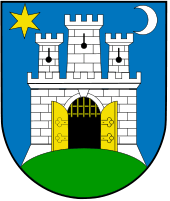Zagreb Cathedral
Zagreb Cathedral, on the Kaptol, is a Roman Catholic institution and not only the tallest building in Croatia but also the most monumental sacral building in Gothic style southeast of the Alps.[3] It is dedicated to the Assumption of Mary and to kings Saint Stephen and Saint Ladislaus. The cathedral is typically Gothic, as is its sacristy, which is of great architectural value. Its prominent spires are considered to be landmarks as they are visible from most parts of the city. One of its two spires was damaged in an earthquake that took place on March 22nd, 2020.
| Zagreb Cathedral | |
|---|---|
| Cathedral of the Assumption of Mary | |
Croatian: Zagrebačka katedrala | |
 | |
 Zagreb Cathedral | |
| 45°48′52″N 15°58′47″E | |
| Location | Zagreb |
| Country | Croatia |
| Denomination | Roman Catholic |
| History | |
| Status | Cathedral |
| Relics held | Sarcophagus of Blessed Aloysius Stepinac, Croatian martyrs Petar Zrinski and Fran Krsto Frankopan, whose bones were transferred from Wiener Neu Stadt in 1919 A.D., Ivan Antun Zrinski, Eugen Kvaternik etc |
| Architecture | |
| Functional status | Active |
| Heritage designation | Register of Cultural Goods of Croatia |
| Designated | 2013 |
| Architect(s) | Hermann Bollé (last reconstruction) |
| Style | Gothic (original) Gothic Revival (19th century reconstructions) |
| Years built | Mid-13th century 1880–1906 (reconstruction/additions) |
| Specifications | |
| Number of spires | 2 |
| Spire height | 108 m (354 ft) |
| Bells | 5 (North Tower) 3 (South Tower)[1] |
| Administration | |
| Archdiocese | Zagreb |
| Clergy | |
| Archbishop | Josip Bozanić |
| Native name Croatian: Zagrebačka katedrala | |
 Location of Zagreb Cathedral in Croatia | |
| Location | Zagreb, Croatia |
| Architect | Hermann Bollé (last reconstruction) |
| Governing body | Zagrebačka katedrala |
| Type | Cultural |
| Designated | March 9, 2013[2] |
| Part of a series on the |
| Catholic Church in Croatia |
|---|
|
History History of the Catholic Church in Croatia History of Croatia–Holy See relations Historical dioceses Diocese of Dubrovnik Diocese of Ston Archdiocese of Zadar Archdiocese of Split Diocese of Šibenik Diocese of Nin Historical people Gregory of Nin Historical sacral architecture Church in Nin Church in Cetina Church of St Donatus |
|
Organisation Episcopal Conference of Croatia Dioceses List of dioceses Archdiocese of Zagreb Archdiocese of Split-Makarska Diocese of Hvar-Brač-Vis Archdiocese of Rijeka Archdiocese of Đakovo-Osijek Schools Archdiocesan Gymnasium Zagreb Pontifical Croatian College Catholic University of Croatia Political Croatian Catholic movement Media Croatian Catholic Radio Other Military Ordinariate of Croatia Apostolic Nunciature |
|
Clergy Pope Francis Ordinaries Josip Bozanić · Josip Mihalović · Franjo Kuharić · Franjo Šeper · Juraj Haulik · Antun Vrančić Juraj Drašković · Aloysius Stepinac |
|
Canonized people |
|
Churches & shrines |
|
History
In 1093 when King Ladislaus (1040-1095) moved the bishop's chair from Sisak to Zagreb, he proclaimed the existing church as a cathedral. Construction on the cathedral started shortly after his death and was finished in 1217 and consecrated by king Andrew II of Hungary. The building was destroyed by the Mongols in 1242 but rebuilt by bishop Timotej (1263-1287) a few years later. At the end of the 15th century, the Ottoman Empire invaded Croatia, triggering the construction of fortification walls around the cathedral, some of which are still intact. In the 17th century, a fortified renaissance watchtower was erected on the south side and was used as a military observation point, because of the Ottoman threat.
The cathedral was severely damaged in the 1880 Zagreb earthquake. The main nave collapsed and the tower was damaged beyond repair. The restoration of the cathedral in the Neo-Gothic style was led by Hermann Bollé, bringing the cathedral to its present form. As part of that restoration, two spires 108 m (354 ft) high were raised on the western side, both of which are now in the process of being restored as part of an extensive general restoration of the cathedral. [4]
The cathedral is depicted on the reverse of the Croatian 1000 kuna banknote issued in 1993.[5]
When facing the portal, the building is 46 meters wide and 108 meters high.[6] The cathedral contains a relief of Cardinal Aloysius Stepinac with Christ done by the Croatian sculptor Ivan Meštrović. The cathedral was visited by Pope Benedict XVI on 5 June 2011 where he celebrated Sunday Vespers and prayed before the tomb of Blessed Aloysius Stepinac.
The cathedral was damaged in the 2020 earthquake on 22 March, in which the tip of its southern spire broke off and crashed onto the roof of the adjacent Archbishop's Palace.[7] On 17 April 2020, the northern spire of Zagreb Cathedral was removed due to leaning during the earthquake.[8][9][10]
Treasury
The cathedral holds a treasury (riznica) that include various metal vessels, liturgical vestments, and liturgical books collected during various periods of its history. Among these objects most notable are medieval St. Ladislaus cloak, Plenarium made out of ivory, and baroque Reliquary-bust of King Saint Stephen.
Gallery
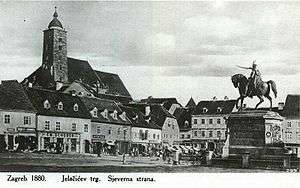 1880 pre-earthquake view from Jelačić Square with old square spire
1880 pre-earthquake view from Jelačić Square with old square spire.jpg) 19th Century view with fortifications intact
19th Century view with fortifications intact- Facade
- Mary column in front of the Cathedral
- Entrance portal
 Eastern view
Eastern view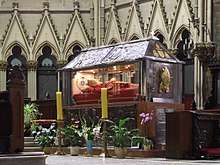 Sarcophagus of blessed Alojzije Stepinac.
Sarcophagus of blessed Alojzije Stepinac.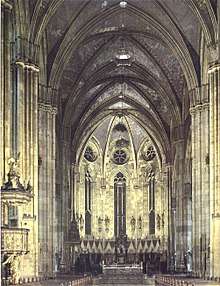 Nave, altar and pulpit
Nave, altar and pulpit Gargoyle on a Zagreb Cathedral
Gargoyle on a Zagreb Cathedral Zagreb skyline with cathedral in the background
Zagreb skyline with cathedral in the background Neo-Gothic tower on a Zagreb Cathedral
Neo-Gothic tower on a Zagreb Cathedral- Lateral interior
- Stained glass
- Interior nave
- Coffin
- Altar
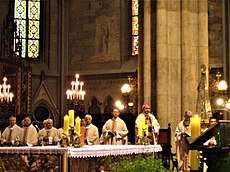 Holy mass
Holy mass
See also
- History of Zagreb
- History of Croatia
- St. Mark's Church
- Kaptol
- Gradec
- Ban Jelačić Square
- List of Gothic Cathedrals in Europe
References
- "Zvona zagrebačke katedrale (Bells of the Zagreb Cathedral)". Glas Koncila (in Croatian).
- Gavrilović, Feđa (12 January 2012). "Razbijene zastarjele predrasude" [Obsolete prejudices shattered]. Vijenac (in Croatian). No. 466. Matica hrvatska. ISSN 1330-2787. Retrieved 7 April 2018.
- Archdiocese of Zagreb - Archdiocese of Zagreb - History of the Cathedral
- Croatian National Bank. Features of Kuna Banknotes Archived 2009-05-06 at the Wayback Machine: 1000 kuna Archived 2009-05-11 at the Wayback Machine. – Retrieved on 30 March 2009.
- Zagreb Cathedral - Visit Zagreb - Zagreb Cathedral
- "Sa zvonika katedrale pao križ i jako oštetio Nadbiskupski dvor kardinala Bozanića". Večernji list (in Croatian). 22 March 2020. Retrieved 22 March 2020.
- "Vrh sjevernog tornja zagrebačke katedrale uspješno uklonjen i spušten na tlo". dnevnik.hr. Retrieved 18 April 2020.
- "Eksplozijama odvojen toranj katedrale, prizemljen je". index.hr. Retrieved 18 April 2020.
- "Rušenje tornja zagrebačke katedrale". hr.n1info.com. Retrieved 18 April 2020.
External links
| Wikimedia Commons has media related to Zagreb Cathedral. |
- Zagreb Cathedral; Zagreb Tourist Info
- Zagreb Cathedral; Visit Zagreb - Travel Guide
- Zagreb Cathedral
- "Đavlova glava u zagrebačkoj katedrali" (in Croatian)
- Zagreb cathedral in the 1880 earthquake and its present day renovation (in Croatian)
